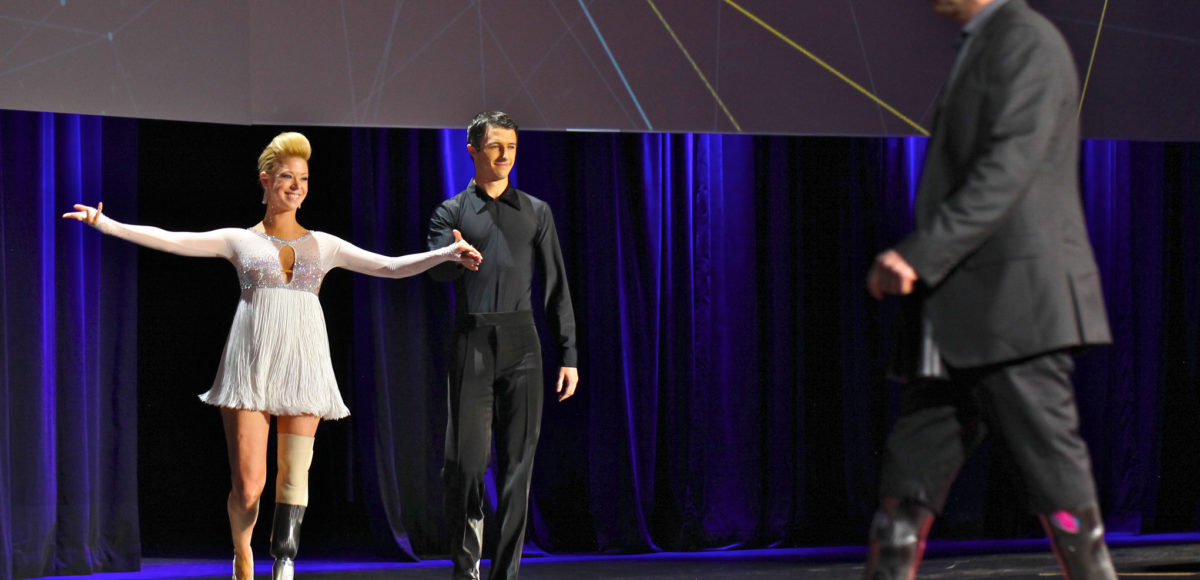The conspirator behind the Boston Marathon bombings was found guilty only days before the second anniversary of the bombings and a week before the second marathon since the attack.
The Boston bombing was a terrible tragedy. Thousands of marathon runners descended upon Boston to celebrate human achievement, and in minutes, their lives were turned into madness and unimaginable terror.
Despite the horrific nature of this event, in the midst of the panic that erupted, people didn’t let the actions of the man behind the Boston Marathon bombing destroy their optimism about their lives and futures. One story in particular illustrates this poignantly.
A year ago, in Vancouver, British Columbia, to the shock and awe of many, Adrianne Haslet-Davis, a dance instructor and professional ballroom dancer, made her dancing debut after losing her left leg in the Boston Marathon bombings. With the help of a bionic prosthetic ankle, Haslet-Davis was able to learn to dance again.
Only days after witnessing gruesome horror and bloodshed with her stitches still in place, Haslet-Davis announced on national television against the unlikely odds that she would dance again.
For months, Haslet-Davis spent hours in intense physical therapy with unwavering focus. When the nub of her left leg swelled up from a poor fitting prosthetic, she endured the pain and kept walking. Every time she fell down, she got back up. Despite the uncertainty of whether she would ever be able to dance again, she had the resilience to keep moving forward in her recovery.
During Haslet-Davis’ recovery, walking through the streets of Boston was a nightmare for her. Everywhere she went, she thought a bomb might explode and that every stranger was out to kill her. Even though she felt this way, she did not succumb to her sorrows. Instead, she continued to live a productive life. She had the honesty to accept that what had happened to her was only one moment in her life and it didn’t have to define the rest. With integrity and courage, she moved forward by persistently trying to find a way to dance again.
But her story doesn’t end there. Despite her determination, Haslet-Davis wouldn’t have been able to dance again without the help of a biomechatronics professor for MIT, Hugh Herr.
A traditional plastic prosthetic leg only allowed Haslet-Davis limited motion, but dancing is a tricky art that requires a full range of movement. To dance, a person has to be able to move consistently to a steady beat in a systematic way. She has to be light on her feet while being able to pivot 360 degrees, all while maintaining a center of gravity. When she tried to move gracefully, her prosthetic leg was like a ball and chain tripping her every step. She needed a prosthetic limb that was light and allowed her a full range of motion. The limb she needed didn’t exist until Hugh Herr created it.
Herr first heard about Haslet-Davis’ story when he saw her initial interview with Anderson Cooper on CNN where she proudly announced she would dance again. After hearing her story and meeting her in person, he realized the only way she would be able to dance again was if he created her a custom bionic leg, and he decided to do just that.
When Herr was 17, he was in a mountain climbing accident on Mount Washington in New Hampshire. He and his friend were stranded in a blizzard for four days that resulted in the amputation of both of his legs. After his accident, Herr felt an overwhelming amount of guilt because the expedition had been his idea. Now he could no longer mountain climb, his friend had lost his left leg, and a rescue worker died in the avalanche trying to save them. Despite his grief, he was determined to climb mountains again.
Before Herr, little advancement had been made in prosthetics. Until the last decade, prosthetics operated very much as they did 500 years ago when they were first invented. Since there were no prosthetics designed to help Herr climb mountains again, he decided to create his own.
At first Herr used raw materials such as scrap metal and wood, but it would not be long before his technique would become more sophisticated. He studied mechanical engineering at MIT and went on to earn his Ph.D. in biophysics at Harvard. Later, he got a postdoc at MIT to study biomedical devices. In 2004, TIME magazine named his computer-controlled knee prosthetic one of the year’s best inventions. In 2011, TIME named Herr the “Leader of the Bionic Age.”
To achieve all that he did, Herr had to have much more than a Ph.D. in biophysics. He had to have honesty to accept what happened to him and then the courage and integrity to move forward with his life. Since no prosthetics were available to help him climb mountains again, he had to be self-reliant and take control of his situation. Through his years of school, he had to have unyielding focus on his goals and endure the demanding and frustrating mental task of discovering new ways to improve prosthetics. His situation seemed bleak, but Herr had to have the determination and perseverance to make it better.
Herr related to Haslet-Davis’ story because of the way she braved circumstances he had faced himself. She was determined not to let the actions of men that tried to kill her define her life. In defiance of the terrorists who tried to end her life, she reclaimed it. Similarly, when nature tried to seize the reins of Herr’s life, he did not surrender. He maintained his control over his life.
For Herr and Haslet-Davis to achieve their goals, they first had to develop the character traits necessary to achieve specific goals and values. Haslet-Davis’ recovery depended on her honesty, productivity, courage, determination, self-reliance, and integrity. And before Herr could help Haslet-Davis, he had to possess these same character traits to pursue his own recovery and a career as an inventor.
By developing the same self-sustaining virtues, Herr and Haslet-Davis were able to improve their lives tremendously. Yet the virtue we are told to strive for today is not selfish dedication to our own lives, but selflessness.
Instead of investing in our own goals, our parents, teachers, and political leaders tell us to dedicate our lives to others. They tell us to put others before ourselves. We are told to devote our time and money to the less fortunate in soup kitchens, retirement homes, and third-world countries. We are told that our happiness is not possible otherwise. We are told that we owe our success to society and that dedicating our lives to others is payment for our debt to them.
But imagine if Herr and Haslet-Davis followed this advice. Would the outcome of their stories have been the same?
If Haslet-Davis had put others before herself after the Boston Marathon bombings, she would have dedicated her time and money to other families affected by the tragedy. But if she had spent her time consoling others impacted by the tragedy, she would not have been able to put the necessary time into the physical therapy she needed to dance again.
If Herr had spent all his time in VA hospitals bonding with veterans who had missing limbs like himself, he wouldn’t have had time to scavenge scrap yards for materials to build new prosthetic limbs, and he wouldn’t have had time to experiment with his new limbs on canyons and cliffs.
Incidentally, Herr and Haslet-Davis have both been able to help others far more by putting their own lives first.
By choosing to create better, more mobile prosthetics, Herr helped Haslet-Davis enormously on her journey to dance again. But before Herr could create a custom prosthetic for her, he first had to pursue his own rational self-interest. Herr’s happiness depended on improving his own life above all.
Haslet-Davis’ dancing triumph has now become an inspiration to other amputees that their disability does not have to be a barrier from achieving their goals. But she had to value her own ability to dance above all other things to be able to offer this inspiration.
What Haslet-Davis and Herr’s story powerfully illustrates to all of us is what a person can accomplish when he pursues his own rational self-interest and what he can accomplish with others who do the same.
Creative commons-licensed image courtesy of Flickr user Steve Jurvetson.





